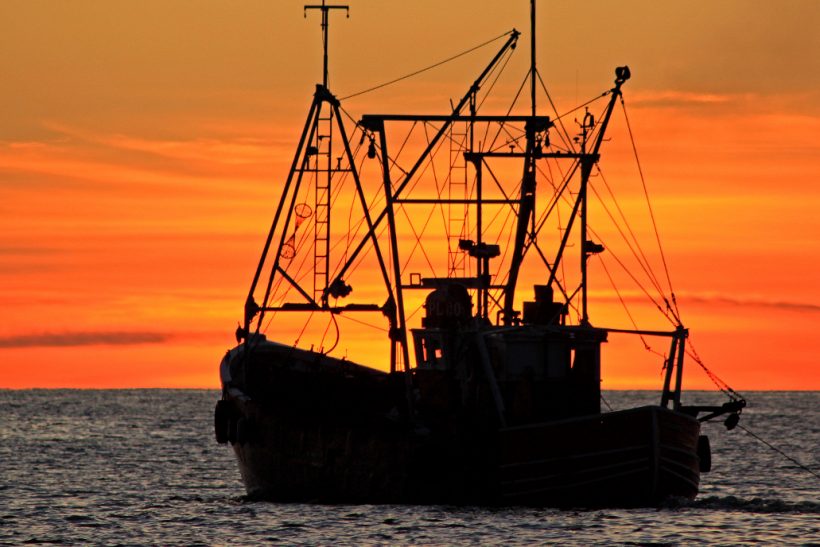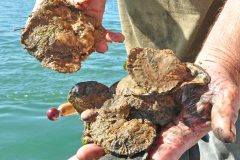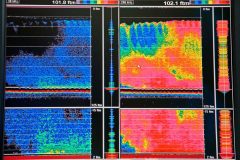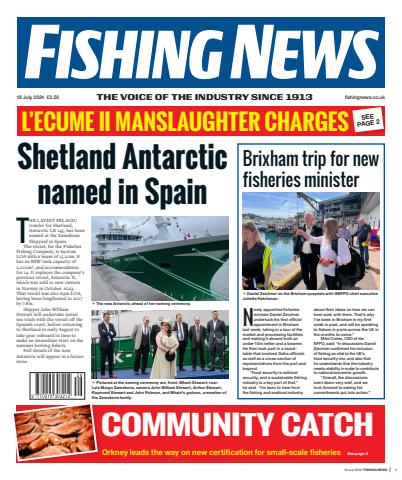Vessel licenses reduced from 156 to 88
New measures to ensure the sustainability of the Isle of Man king scallop fishery, including the introduction of an inshore marine zoning plan, are to be introduced, the Isle of Man government announced last week.
From the start of the 2016 – 2017 season, on 1 November, the number of licences issued by the Department of Environment, Food and Agriculture (DEFA) to fish for king scallops within the island’s seas will be reduced. Eligibility will be determined by vessels’ track record of fishing for king scallops over the past few seasons, with vessels’ size taken into account.
The measure follows a public consultation, conducted by DEFA during the summer. The consultation attracted 84 responses and showed overwhelming support for the introduction of a reduction in the number of licences issued. Explaining the need for the measure, Richard Lole, chief executive officer of the Department of Environment, Food and Agriculture, said: “In recent years, there has been a significant increase in the number of vessels fishing for king scallops in Manx waters and a corresponding increase in the catch.
“In 2015-2016, 4,500 tonnes of king scallops were landed in the island, worth £4m at the quayside.
“At the same time, indications are that stock is under increasing pressure, prompting concerns over the sustainability of this valuable fishery.
“The new measures will protect those vessels that can demonstrate a historic interest and dependence on the fishery, while safeguarding the fishery in the long term.”
At the same time, the first stages of a new inshore marine zoning plan will also be introduced by DEFA. This follows a separate public consultation carried out in the spring. The area between the shore and three miles out to sea is home to important species. It accommodates many recreational/leisure activities as well commercial fishing, particularly ‘pot’ fisheries for crab and lobster.
In order to better balance these diverse interests, five new inshore conservation zones will be established around the coastline, where commercial dredge and trawl fishing will be prohibited, but potting and recreational fishing can continue.
Outside the new zones, dredge and trawl fishing can continue within three miles of the shoreline but with additional access restrictions – again based largely on past effort and landings.
The new zoning proposal has been developed in close liaison with fisheries and conservation interests, and reflects the strong local support for a healthy and balanced inshore marine environment.
The island’s territorial sea extends for 22km (or 12nm) and covers some 4,000km2 in area. Through its Future Fisheries, Managing our Natural Wealth, and Food Matters strategies, DEFA is aiming to ensure that the economically-important fishing industry, and the marine environment that supports it, are protected for the long term.
Isle of Man King Scallop Fishery 2016 – Statement
Background
Evidence strongly indicates that the Isle of Man king scallop fishery has expanded significantly in recent years, with a year-on-year increase in vessel numbers and a corresponding decline in landings per unit effort (LPUE). In view of growing concerns, a consultation on proposals for the future management of the Isle of Man king scallop fishery was launched in July 2016 by Isle of Man government. The proposed management measures aim to reduce the latent capacity in the fleet, reduce current effort levels and ensure the long-term sustainability of the stock.
An impact assessment examining the likely impacts on the fishing fleet of the proposed management measures accompanied the consultation, based on vessel numbers, effort (kW days) total landings of product and Landings Per Unit Effort (LPUE).
Consultation summary
A total of 84 responses were received to the consultation, with 77% of these being from the catching and processing sectors; the remainder consisting of NGOs, UK FAs and other government departments.
In summary, there was 92% support for the introduction of a cap on the number of licences issued in respect of the Isle of Man king scallop fishery and, of these, 84% supported a reduction in the number of licences issued in respect of the fishery.
With regards to the most appropriate reference period for establishing entry to the fishery, there was 65% support for the earliest track record period of 1 November 2010 – 31 May 2013. With regards to the most appropriate number of fishing days to constitute an eligible track record for entry to the fishery, 68% of respondents supported at least 50 days.
There were also positive responses to the creation of a king scallop management board (86%) and the introduction of a tow bar length restriction (77%), however there was little support for a weekend ban. The various other options suggested for future management of the fishery received support in fairly equal measures, and many respondents submitted further ideas.
Proposal
In attempting to balance the biological need of the stock with the socio-economic impact, while taking into account the detailed consultation feedback, various combinations of different reference periods and track records have been examined to identify a balanced and effective solution.
In order to best accommodate all interests, a four-year reference period comprising the Isle of Man king scallop fishing seasons 2011-2012 to 2014-2015 has been selected, to be combined with:
- For under-15m vessels, a minimum of 50 days’ fishing activity in ICES statistical rectangles 36, 37 & 38E5
- For over-15m vessels, a minimum of 26 days’ fishing activity in ICES statistical rectangles 36, 37 & 38E5
The number of king scallop fishing days in any one season (1 November – 31 May) is approximately 210, and so 50 days over a four-year period represents 6% of available fishing opportunities.
As over-15m vessels have been restricted in fishing activity from 2011, due to the Western Waters Effort Regime, the total number of fishing days available in this period has been calculated to be 425. This allows a figure of 26 days to be used for the track record for this class of vessel, based on 6% of available fishing opportunities.
The above track record will result in a reduction in vessel number from 156 to 88, and will reduce the number of days fished in the territorial sea by approximately 19%. There will be an overall reduction of 16% in kW days effort, and latent capacity within the fleet will reduce by 44%.
2016-2017 king scallop season
The department began issuing new licences to eligible vessels for the forthcoming Isle of Man king scallop season last week, on October 10. A robust appeals procedure will be in place for those vessels not qualifying for entry.
Future management measures
The consultation proposed arange of additional managementmeasures, including a quota-basedsystem, which could beconsidered in the future. Furthermeasures, including a review of‘grandfather right’ vessels werealso suggested. The departmentrecognises the support forrestrictions on tow bar length andthis will be investigated further indue course.
A stock assessment for king scallops within Isle of Man waters remains under development to improve knowledge of king scallop stock levels. The data used for the stock assessment comes, in large part, from annual surveys, and available information indicates that several potential methods may be applicable. It is intended that a robust peer-reviewed assessment of the analysis for each method will be undertaken via the ICES scallop working group.
The department will consider the stock assessment outcome when available, and reserves the right to introduce further measures should there be a need. Similarly, should it be apparent the stock can sustain additional effort, the department will consider the release of additional licences, using documented criteria.
Further information can be obtained by contacting the DEFA Fisheries Directorate on: 01624 685857 or via email at: fisheries@gov.im.
Read more from Fishing News here.


Vessel licenses reduced from 156 to 88 New measures to ensure the sustainability of the Isle of Man king scallop fishery, including the introduction of an inshore marine zoning plan, are to be introduced, the Isle of Man government announced last week. From the start of the 2016 – 2017 season, on 1 November, the number of licences issued by the Department of Environment, Food and Agriculture (DEFA) to fish for king scallops within the island’s seas will be reduced. Eligibility will be determined by vessels’ track record of fishing for king scallops over the past few seasons, with vessels’ size taken into account. The measure follows a public consultation, conducted by DEFA during the summer. The consultation attracted 84 responses and showed overwhelming support for the introduction of a reduction in the number of licences issued. Explaining the need for the measure, Richard Lole, chief executive officer of the Department of Environment, Food and Agriculture, said: “In recent years, there has been a significant increase in the number of vessels fishing for king scallops in Manx waters and a corresponding increase in the catch. “In 2015-2016, 4,500 tonnes of king scallops were landed in the island, worth £4m at the quayside. “At the same time, indications are that stock is under increasing pressure, prompting concerns over the sustainability of this valuable fishery. “The new measures will protect those vessels that can demonstrate a historic interest and dependence on the fishery, while safeguarding the fishery in the long term.” At the same time, the first stages of a new inshore marine zoning plan will also be introduced by DEFA. This follows a separate public consultation carried out in the spring. The area between the shore and three miles out to sea is home to important species. It accommodates many recreational/leisure activities as well commercial fishing, particularly ‘pot’ fisheries for crab and lobster. In order to better balance these diverse interests, five new inshore conservation zones will be established around the coastline, where commercial dredge and trawl fishing will be prohibited, but potting and recreational fishing can continue. Outside the new zones, dredge and trawl fishing can continue within three miles of the shoreline but with additional access restrictions – again based largely on past effort and landings. The new zoning proposal has been developed in close liaison with fisheries and conservation interests, and reflects the strong local support for a healthy and balanced inshore marine environment. The island’s territorial sea extends for 22km (or 12nm) and covers some 4,000km2 in area. Through its Future Fisheries, Managing our Natural Wealth, and Food Matters strategies, DEFA is aiming to ensure that the economically-important fishing industry, and the marine environment that supports it, are protected for the long term.




